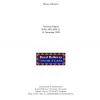Free Online Productivity Tools
i2Speak
i2Symbol
i2OCR
iTex2Img
iWeb2Print
iWeb2Shot
i2Type
iPdf2Split
iPdf2Merge
i2Bopomofo
i2Arabic
i2Style
i2Image
i2PDF
iLatex2Rtf
Sci2ools
102
click to vote
DCC
2007
IEEE
2007
IEEE
Sequential and dynamic frameproof codes
There are many schemes in the literature for protecting digital data from piracy by the use of digital fingerprinting, such as frameproof codes and traitor-tracing schemes. The concept of traitor tracing has been applied to a digital broadcast setting in the form of dynamic traitor-tracing schemes and sequential traitor-tracing schemes, which could be used to combat piracy of pay-TV broadcasts, for example. In this paper we extend the properties of frameproof codes to this dynamic model, defining and constructing both l-sequential frameproof codes and l-dynamic c-frameproof codes. We also give bounds on the number of users supported by such schemes.
Related Content
| Added | 13 Dec 2010 |
| Updated | 13 Dec 2010 |
| Type | Journal |
| Year | 2007 |
| Where | DCC |
| Authors | Maura B. Paterson |
Comments (0)

